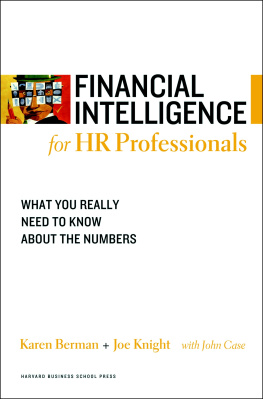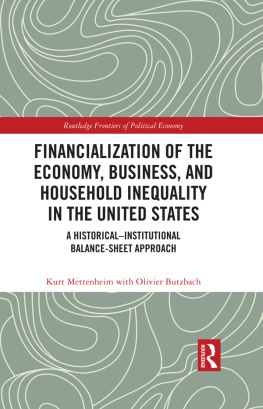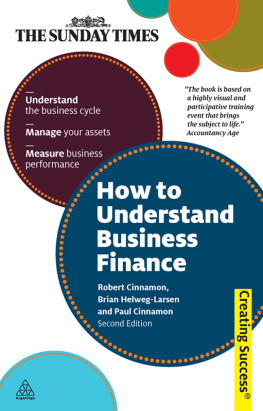How to READ a Balance Sheet
Rick J. Makoujy, Jr.


Copyright 2010 by The McGraw-Hill Companies, Inc. All rights reserved. Except as permitted under the United States Copyright Act of 1976, no part of this publication may be reproduced or distributed in any form or by any means, or stored in a database or retrieval system, without the prior written permission of the publisher.
ISBN: 978-0-07-170344-4
MHID: 0-07-170344-6
The material in this eBook also appears in the print version of this title: ISBN: 978-0-07-170033-7, MHID: 0-07-170033-1.
All trademarks are trademarks of their respective owners. Rather than put a trademark symbol after every occurrence of a trademarked name, we use names in an editorial fashion only, and to the benefit of the trademark owner, with no intention of infringement of the trademark. Where such designations appear in this book, they have been printed with initial caps.
McGraw-Hill eBooks are available at special quantity discounts to use as premiums and sales promotions, or for use in corporate training programs. To contact a representative please e-mail us at bulksales@mcgraw-hill.com.
This publication is designed to provide accurate and authoritative information in regard to the subject matter covered. It is sold with the understanding that neither the author nor the publisher is engaged in rendering legal, accounting, futures/securities trading, or other professional service. If legal advice or other expert assistance is required, the services of a competent professional person should be sought.
From a Declaration of Principles jointly adopted
by a Committee of the American Bar Association
and a Committee of Publishers
TERMS OF USE
This is a copyrighted work and The McGraw-Hill Companies, Inc. (McGraw-Hill) and its licensors reserve all rights in and to the work. Use of this work is subject to these terms. Except as permitted under the Copyright Act of 1976 and the right to store and retrieve one copy of the work, you may not decompile, disassemble, reverse engineer, reproduce, modify, create derivative works based upon, transmit, distribute, disseminate, sell, publish or sublicense the work or any part of it without McGraw-Hills prior consent. You may use the work for your own noncommercial and personal use; any other use of the work is strictly prohibited. Your right to use the work may be terminated if you fail to comply with these terms.
THE WORK IS PROVIDED AS IS. McGRAW-HILL AND ITS LICENSORS MAKE NO GUARANTEES OR WARRANTIES AS TO THE ACCURACY, ADEQUACY OR COMPLETENESS OF OR RESULTS TO BE OBTAINED FROM USING THE WORK, INCLUDING ANY INFORMATION THAT CAN BE ACCESSED THROUGH THE WORK VIA HYPERLINK OR OTHERWISE, AND EXPRESSLY DISCLAIM ANY WARRANTY, EXPRESS OR IMPLIED, INCLUDING BUT NOT LIMITED TO IMPLIED WARRANTIES OF MERCHANTABILITY OR FITNESS FOR A PARTICULAR PURPOSE. McGraw-Hill and its licensors do not warrant or guarantee that the functions contained in the work will meet your requirements or that its operation will be uninterrupted or error free. Neither McGraw-Hill nor its licensors shall be liable to you or anyone else for any inaccuracy, error or omission, regardless of cause, in the work or for any damages resulting therefrom. McGraw-Hill has no responsibility for the content of any information accessed through the work. Under no circumstances shall McGraw-Hill and/or its licensors be liable for any indirect, incidental, special, punitive, consequential or similar damages that result from the use of or inability to use the work, even if any of them has been advised of the possibility of such damages. This limitation of liability shall apply to any claim or cause whatsoever whether such claim or cause arises in contract, tort or otherwise.
CONTENTS
PREFACE
Dont be afraid of this book. My intention is to explain financial statements and related concepts in easy-to-understand language, not confusing industry jargon as is found in every other finance-related work Ive seen. The goal is to impart solid comprehension. If you cant do so already, after carefully reading this book you will be able to understand the business section of any newspaper, including my favorite, The Wall Street Journal. You will also find that while that the skills and knowledge described herein are business oriented, there are also parallels throughout this book to ones personal financial well-being.
...
The genesis of this book is, as Paul McCartney and John Lennon (mostly McCartney), so eloquently put it, a Long and Winding Road, but which may be succinctly summarized as accounting is taught wrong. While I scraped by with a B in Accounting 101 as an undergraduate at Vanderbilt University, I walked away from the course feeling slightly less educated than I was before the class started. It seemed as though the professor received satisfaction from tricking the students. Sooo, she would say while pointing to the board wearing a Cheshire cat grin, Is it a debit or a credit? Most of the class would sheepishly state in nervous whispers, Debit? No! she would thunder. Its a credit! Ha, ha, ha!
I learned much later that she was, in effect, teaching us a little bit of brain surgery. Unless her students were likely to be accounting professionals in some capacity, general ledger entries and debits and credits only serve to confuse the bigger picture (which, frankly, is all that most people will ever need but few will ever properly understand).
After college, I landed a job with Price Waterhouses (PW) Restructuring Practice in New York City. We helped those who were owed money (i.e., creditors) from companies in bankruptcy (i.e., debtors) figure out what they might ultimately recover as a percentage of what they were owed. As a junior professional, my job was to input data and create many spreadsheets. (I became a Lotus 123 wiz.) Despite PWs status of being a premier Big Six accounting firm (alongside Coopers & Lybrand, which later merged with PW; Arthur Anderson, which later imploded during the Enron document shredding scandal; Deloitte & Touche; Ernst & Young; and KPMG Peat Marwick), I really wasnt close to being proficient in accounting, even after a couple of years. My salary seemed generous on the surface until I moved New York City, absorbed the much higher cost of living, and divided my income by the hours worked.
Two years later, anxious to move past paycheck-to-paycheck living, I solicited various Wall Street firms for open positions. Fortunately, the Price Waterhouse name on my rsum opened interview doors; I landed a job as a securities analyst for a distressed securities brokerage firm that had broken off from Bear Stearns. (Remember them?) The firm was relatively small and had no formal training program but assumed that my skills were far more advanced than they were. I was asked on my first day to create projected balance sheets for a company in bankruptcy protection. I had no clue as to what to do. Fearful of losing the job I so badly needed, I sat down with an annual report and my trusty Lotus 123 spreadsheets.
Starting with the relatively straightforward income statement, I figured out the simple subtraction to get from revenue to net income. However, the interaction between the statements proved to be more of a challenge. If net income increased, shouldnt cash on the balance sheet go up by the same amount? After some contemplation, it occurred to me that, for example, if a company had recorded a sale but had not yet gotten paid, its receivables (money owed by customers) would go up. This increase in receivables, while still counted as part of net income, would not increase cash until the customers paid their bills. Making similar adjustments for increases in equipment purchases and borrowings, I finally got the result I so desperately sought: the balance sheet balanced. In other words, the companys assets equaled its liabilities plus net worth. My first reaction was relief and joy. My second was: Why hadnt anyone ever explained financial statements to me like this before? Career lightbulb no.1 went on.






